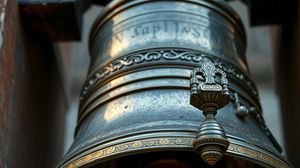
The London Stone, housed at 111 Cannon Street, is a mysterious and ancient relic in the heart of the City of London. This block of limestone has mystified historians and intrigued visitors for centuries. Its origins are shrouded in legend, but what is known is that it has been a part of London's history since at least the medieval era.
The exact purpose and origins of the London Stone are unknown, leading to a multitude of theories. Some have speculated it was a Roman milestone, while others believe it may have been a Druidic altar stone or a prehistoric relic linked to the foundation of London itself. This air of mystery adds to the allure of the stone.
The London Stone has been referenced in literature, suggesting its importance in England's cultural history. William Shakespeare even alluded to it in his play "Henry VI, Part 2," highlighting its longstanding prominence in the city's lore. This cultural presence has cemented the stone's status as a significant historical artifact.
During its long history, the London Stone has moved locations multiple times but has remained an important symbol of London. This rock has witnessed the city's immense growth and transformation over the centuries, making it a silent yet steadfast witness to history.
A popular legend claims that the safety of London is tied to the London Stone. The saying "So long as the stone of Brutus is safe, so long shall London flourish" suggests that the city's prosperity is linked to the stone's preservation, contributing to its mystique and revered status among Londoners.

Making the Most of Your Visit:
If you've planned a visit to the London Stone, remember that it's housed within an unassuming building at 111 Cannon Street. It's easy to miss if you're not paying attention, so keep an eye out for the modern building with a small protective enclosure for the stone.
The stone is encased behind glass for protection, so don't expect to be able to touch it. However, it's still worth appreciating its mysterious aura up close through the glass. Take your time to ponder its historical significance and the many legends surrounding it.
The stone's current location doesn't have its own museum or extensive information boards, so it's a good idea to read up on its history and the associated legends before your visit to fully appreciate its enigmatic allure.
While you're there, make sure to imagine the journey the stone has taken over the centuries. Its historical importance is amplified by its survival through the Great Fire of London, wars, and the constant evolution of the city. Contemplating this can add a new layer of depth to your experience.
Be mindful that the London Stone has significance to some locals; it's not just an artifact but a symbol soaked in the lore and longevity of London itself. Respect this sentiment as you browse its past and present.

Visiting Times & Costs:
The London Stone is accessible to the public at no cost.
It is housed within a modern building at 111 Cannon Street and is typically viewable during the building's standard opening hours. However, it's advisable to check ahead as these can be subject to change.
There are no special accessibility issues, but as the stone is viewed through a glass case in the building's frontage, wheelchair users should generally be able to access the viewing area.
Please note that as it is located in a commercial building, public holidays or building-specific events may affect access.

Address & Map:

Nearby:























